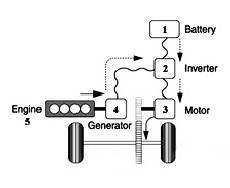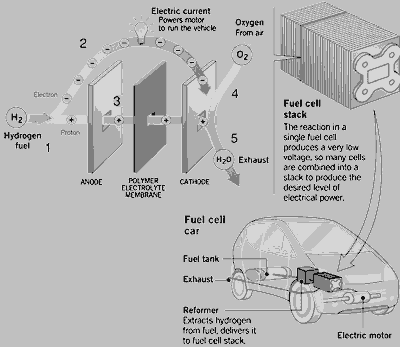Hybrid and Hydrogen Cars
Changing the way that we power
our cars is one of the most promising ways of reducing pollution yet keeping our
mobility. Hybrid cars are already available and some companies have
produced some experimental hydrogen cars that have shown their enormous
potential. How they work is described next.
Hybrid Cars
The main source of power in a
hybrid car is the internal combustion engine. However, in order to stretch
the fuel as far as possible, the
wheels are also driven by an electric motor. Depending upon road
conditions, demand on the engine etc, a computer decides whether to use petrol
or electric power.
Different
hybrid systems work in different combinations. Some will use the petrol engine
only when moving off from rest and at low speeds, but when accelerating, its
computer asks the electric motor to chip in with extra help. As cruising speeds
are reached, the electric motor is turned off, leaving petrol power only. When
the driver starts to slow down the electric motor becomes a generator and
transfers the kinetic energy of the car into the battery as electric power. This
is called 'regenerative braking'. Whenever the car comes to a stop, the computer
turns off the engine to save fuel and CO2 emissions.
Other hybrid cars combine the
electric motor, the internal combustion engine and the battery so that the
electric motor can operate on its own when light acceleration is needed at lower
speeds. Once the vehicle reaches higher speeds, the internal combustion engine
starts up and takes over. Under hard acceleration, both the internal combustion
engine and the electric motor can work together to provide the needed power.
These hybrids are able to generate and consume electricity at the same time.
combustion engine and the battery so that the
electric motor can operate on its own when light acceleration is needed at lower
speeds. Once the vehicle reaches higher speeds, the internal combustion engine
starts up and takes over. Under hard acceleration, both the internal combustion
engine and the electric motor can work together to provide the needed power.
These hybrids are able to generate and consume electricity at the same time.
Hybrid cars can achieve 83mpg
and carbon dioxide output of 80g/km in the combined cycle - that's considerably
better than a small diesel car which can manage a hugely impressive 64mpg and
119g/km. There are two hybrid cars available for sale already and other
companies are planning to introduce some soon.
Hydrogen
Cars
There are two ways that hydrogen
cars could work: with a modified internal combustion engine or with fuel cells.
Hydrogen cars hold a lot of promise as there are no harmful emissions, no
depleting of resources, and no danger to the atmosphere. Having said this
one disadvantage of hydrogen cars is that energy is needed to produce the
hydrogen so whilst the car itself may be clean (electric cars have this problem
as well) pollutants may have been generated whilst producing the hydrogen.
BMW have developed a hydrogen
car which as two fuel induction systems: one for petrol and one for hydrogen.
It is more space efficient to store the hydrogen in liquid form, which means a
specially insulted tank is needed since the hydrogen is very cold, -253 °C!
 BMW,
in partnership with the Shell Oil Company, have developed a way of filling cars
up with hydrogen at a petrol station. The world's first fully automatic
hydrogen filling station was opened in May 1999 at the Munich Airport.
BMW,
in partnership with the Shell Oil Company, have developed a way of filling cars
up with hydrogen at a petrol station. The world's first fully automatic
hydrogen filling station was opened in May 1999 at the Munich Airport.
BMW
have also been part of developments that have resulted in using solar power to
produce hydrogen. Heat from the sun is captured using solar panels.
This energy is then used to split water into hydrogen and oxygen (a process
called electrolysis). The hydrogen is then stored at the low temperatures
required to save space. This method is promising since the energy that is
acquired for electrolysis is obtained using solar energy therefore avoiding
producing pollutants.
A
small company in America, The Hydrogen Car Company has also produced hydrogen cars using a modified internal combustion engine. They have been able to
show that you can have a high performance sports car and still be
environmentally friendly. They have produced a modified Shelby Cobra.
Its performance figures are on a par with normal Cobras as it has a top speed of
140mph and can reach 60mph in 4 seconds. Shelby Automobiles produce the
cars then the Hydrogen car company carry out the modifications.
cars using a modified internal combustion engine. They have been able to
show that you can have a high performance sports car and still be
environmentally friendly. They have produced a modified Shelby Cobra.
Its performance figures are on a par with normal Cobras as it has a top speed of
140mph and can reach 60mph in 4 seconds. Shelby Automobiles produce the
cars then the Hydrogen car company carry out the modifications.
Two
disadvantages are the range of the hydrogen fuel tank (about 80 miles in the
Cobra and 240 miles in the BMW) and the cost. The tank is also placed in
the boot so it reduces luggage space. It costs about £26,700 pounds to
convert a Cobra. The costs of hydrogen cars would come down once they were
being produced on an assembly line though.
 Hydrogen
cars fitted with fuel cells have a longer range and are favoured by most of the
large car companies. The same amount of hydrogen will take a fuel cell car
at least twice as far as one with a converted internal combustion engine. Fuel cells have made electric cars much more practical because they don't
need
large banks of batteries to keep them going. This is because fuel cells
make electricity as the car goes along road.
Hydrogen
cars fitted with fuel cells have a longer range and are favoured by most of the
large car companies. The same amount of hydrogen will take a fuel cell car
at least twice as far as one with a converted internal combustion engine. Fuel cells have made electric cars much more practical because they don't
need
large banks of batteries to keep them going. This is because fuel cells
make electricity as the car goes along road.
Recent developments in
technology have greatly increased the amount of power that a stack of cells –
small enough to fit under a car’s bonnet – can provide. This has opened up
the prospect of non-polluting electric cars with the levels of performance we
expect from conventional vehicles. Car manufacturers expect to start
mass-producing fuel cell hydrogen cars between 2012 and 2020.
 combustion engine and the battery so that the
electric motor can operate on its own when light acceleration is needed at lower
speeds. Once the vehicle reaches higher speeds, the internal combustion engine
starts up and takes over. Under hard acceleration, both the internal combustion
engine and the electric motor can work together to provide the needed power.
These hybrids are able to generate and consume electricity at the same time.
combustion engine and the battery so that the
electric motor can operate on its own when light acceleration is needed at lower
speeds. Once the vehicle reaches higher speeds, the internal combustion engine
starts up and takes over. Under hard acceleration, both the internal combustion
engine and the electric motor can work together to provide the needed power.
These hybrids are able to generate and consume electricity at the same time.

